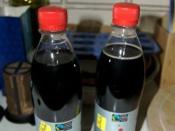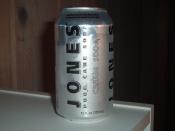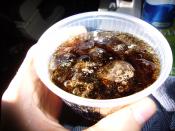Introduction: The purpose of this experiment was to investigate the harmful effects of drinking soda. The main purpose of this experiment was to study the effects of soda particularly on bones. Similar experiments to study the effects of soda are conducted in Loma Linda University, and as Hans Diehl, MD, suggest in order neutralize a glass of cola, it takes 32 glasses of high pH alkaline water. pH is the scale to measure the acidity of the solution. The pH of water is around 7, indicating that it is neutral; anything, which falls below 7, is acidic. If the factor of pH is decreased by 1 unit, from 7pH to 6pH, the acidity of the solution actually increases by 100 times. From this one can imagine how high the pH value of soda is, and for the fact, the normal soda that is available at all places has an average pH of 3.4.
So when you are buying a can of coke, you are actually buying a can of acid, which can easily dissolve bones.
Materials and Method: Materials that were needed in the experiment were small pieces (chicken bones), sodas (Pepsi, 7up), tap water, and glass bottles.
3 pieces of chicken bones were needed for this experiment. They were cleaned thoroughly to remove all unwanted body, and dried. These bones were then measured using a sensitive weighing machine and he weights of the bones were recorded.
Three glass bottles were used in this experiment. The 1st bottle contained Pepsi, the 2nd bottle contained 7up, and the 3rd bottle contained water (as a control). Each bottle contained 1 glass (approximately 200 ml) of Pepsi, 7up, and water respectively. The three pieces of bones were placed in each bottle, and the bottle was tightly sealed with the help of rubber cork, so that there is no interaction between the outside and the inside air. The bottles were kept at room temperature for five days.
After five days, weight of the bones were measured again, and recorded. The liquids in each bottle were discarded.
Results: Data Table: Initial Weight (g) Final Weight (g) Amount of bone that dissolved (g) Pepsi 0.0460 0.0328 0.0132 7up 0.0761 0.0490 0.0271 Water 0.0364 0.0362 0.0002 Discussion: As the result suggests, the bones did get dissolved by soda. The maximum portion the bone is made of calcium, which can be dissolved in acid. Bones kept it acid were dissolved by the acid in just five days, and as the result show, just within five days, 0.0132 grams of bone was dissolved in Pepsi, and 0.0271 grams of bone dissolved in 7up.
Of course these bones were dead bones, meaning that they were not supplied by any bodily nutrients to keep them healthy. The bones that are present in the body are constantly nourished. The body recovers the wear and tear of bones, at the same time the body also develops and grows new bones, but this is only up to the age of 30 and no more growth of bones take place, and the ability to nourish the bones also decreases. After that the bones dissolve about 8-18% each year through the urine depending on the acidity of the food intake. As in children the harm caused by intake of soda cannot be seen instantaneously, but as the aging takes place, the bones become fragile, as the calcium is dissolved by the soda.
From the experiment that I conducted, it clearly shows that soda proves to be very harmful to the body, making the bones fragile. The bones kept for five days in soda were dissolved by 67.65 percent on average. This also means that if the bones had been exposed to soda for more days, it would have been completely dissolved in it. Similarly our body is exposed to soda too. As surveys conducted, on an average, a person drinks at least three cans of soda.
But it is not only the acidic nature of soda that is dangerous to body, sodas also have very high content of caffeine in it. On an average 12 ounce of soda has 34.5 grams of caffeine, the diet coke, which is suppose to be sugar free, has in fact more caffeine content in it, about 43 grams. The result of this is that, it causes obesity, tooth decay, caffeine dependence, and the worst is the weakened bones. Osteoporosis is a disease causing fragile and broken bones. Soda, which contains phosphorus, lowers the amount of calcium in the blood, which can lead to problems of calcium deficiency, including osteoporosis. High-sugar diets may contribute to heart disease in people who are diabetic. Caffeine, which is also in soda, causes nervousness, irritability, sleeplessness, and rapid heart beat. Caffeine causes in children who normally do not consume much caffeine to be restless and fidgety, develop headaches, and have difficulty going to sleep. Red dyes that are used in soda to give its color, cause hyperactivity in sensitive children. Yellow dye causes asthma, hives, and a runny nose.
The better option when one is thirsty is, to drink water, or milk, or 100% fruit juice. Therefore the intake of coke must be highly reduced from our diets.





